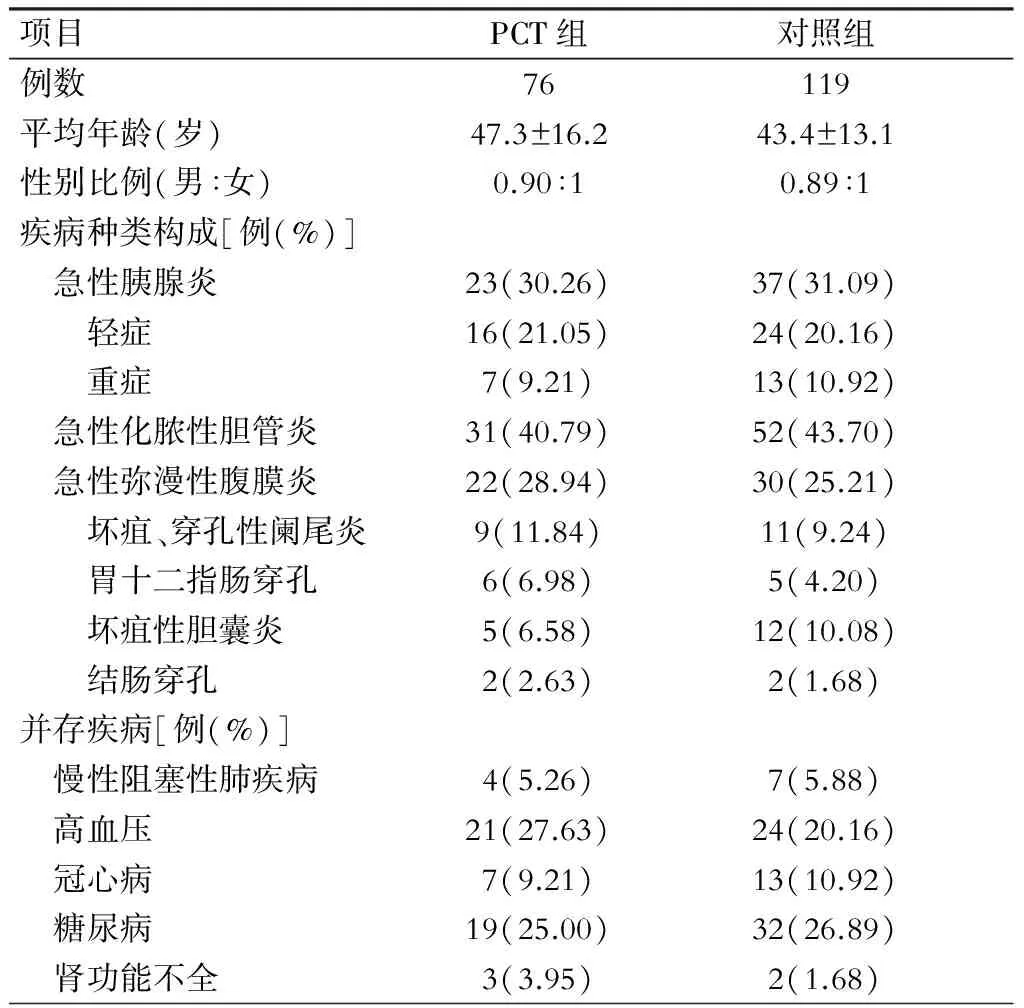降钙素原指导下减少腹部外科感染抗生素使用的临床研究
2016-07-05李荣彭开勤朱国超余阳
李荣 彭开勤 朱国超 余阳
·论 著·(临床研究)
降钙素原指导下减少腹部外科感染抗生素使用的临床研究
李荣 彭开勤 朱国超 余阳
目的 研究腹部外科感染病例中根据血清降钙素原(procalcitonin,PCT)的水平和变化情况来指导抗生素的使用,探讨PCT能否减少抗生素的使用,同时不增加严重的不良反应。方法 回顾性分析腹部外科急性胰腺炎、急性化脓性胆管炎和急性弥漫性继发性腹膜炎病例的抗生素使用情况及治疗结果。病人分为两组,PCT组(76例)和传统标准治疗组(对照组,119例)。在PCT组按照预定的PCT浓度截断值开始和停止抗生素的使用,对照组按传统标准使用抗生素。结果 PCT组较对照组抗生素使用天数减少2.6 d。感染并发症和病死率两组差异无统计学意义。结论 PCT指导的抗生素治疗方案较传统标准方案可降低抗生素的用量,并且不增加不良的医疗结果。
降钙素原;感染;抗生素;腹部外科
抗生素的广泛使用不仅增加了医疗成本,加大了抗生素不良反应的风险,而且使得细菌耐药性越来越强,甚至催生出超级细菌。如何在合理的基础上减少抗生素使用对临床是一个挑战。已有研究[1-3]表明,基于降钙素原(procalcitonin,PCT)指导下的抗生素治疗方案在社区获得性肺炎和重症监护病人的治疗中可以降低抗生素的用量而在临床疗效上不劣于标准的抗生素疗法。腹部外科中其运用如何,国内尚未见报道。在腹部外科中急性化脓性胆管炎、急性胰腺炎和急性弥漫性腹膜炎是常见且抗生素使用较频繁的疾病,本研究回顾性分析我科上述疾病基于PCT的疗法较传统标准抗生素治疗方法是否可以减少抗生素的使用,以及严重的不良预后是否会增加。
资料与方法
一、研究对象
选取腹部外科中急性化脓性胆管炎、急性胰腺炎和急性继发性弥漫性腹膜炎为研究病种。排除标准:①长期使用免疫抑制剂者;②年龄>70岁。2012年6月至2015年2月入住我院的病人,入组76例,依据PCT水平指导抗生素的使用。回顾比较2011年9月至2014年6月时间段入住我科的上述3种疾病的病人,共119例,其抗生素的使用是依据传统的标准方案,作为对照组。
二、研究设计
详细记录病人入院后连续监测的PCT水平、抗生素使用、病人疾病的转归和感染性并发症的情况。PCT的检测采用法国梅里埃公司VIDAS全自动酶联荧光分析仪,罗氏诊断产品有限公司BRAHM的前降钙素全定量试剂盒。
三、分组与抗生素治疗标准
1.PCT指导组 依据PCT的浓度决定是否开始抗生素治疗,通过连续监测的PCT浓度来决定是否停用抗生素。当PCT的浓度低于峰浓度的80%或者绝对浓度低于0.5 μg/L的时候,建议停用抗生素。具体建议见表1。
2.标准治疗组(对照组) 急性化脓性胆管炎入院确诊后即开始使用抗生素。急性胰腺炎合并胆管炎的归入急性胆管炎病例。单纯的急性胰腺炎轻症无合并感染的不用抗生素,重症者预防性使用抗生素。急性弥漫性腹膜炎病人保守治疗者治疗性用抗生素;手术治疗者所有病例均于术前30~60 min经静脉给予单剂预防性抗生素。术后根据我科腹膜炎评分[4]决定抗生素的使用。腹膜炎评分据体温、白细胞计数、液体正平衡量和腹膜炎分期进行评分,以上4项之和为腹膜炎评分。评分方法见表2。其中,液体正平衡量即手术日输液总量减去当日尿量、各种引流量,减去皮肤呼吸道和术中创面非显性失水量。腹膜炎分期标准:Ⅰ期为局限性炎症,腹膜无镜面光泽;Ⅱ期即局限性炎症,纤维素苔易剥离;Ⅲ期即弥漫性炎症,腹膜充血无镜面光泽;Ⅳ期即弥漫性炎症,纤维素苔易剥离;Ⅴ期即弥漫性炎症,纤维素苔不易剥离。评分在手术日24 h内进行。评分≤6分为轻症,不再用抗生素;≥7分为中、重症,术后治疗性应用抗生素。3种疾病依据传统的体温和血象正常后3 d停用抗生素。
考虑到临床的风险和安全性问题,使用抗生素的最终决定仍取决于主治医师,但标准的遵循与否要进行记录,并记录原因。
四、统计学分析

结 果
一、2组病人基本特征比较
2组平均年龄比较差异无统计学意义(P=0.75)。2组病人基本特征是平衡的(表3)。
二、2组观察
PCT组平均抗生素使用的天数为6.8 d,较对照组平均抗生素使用天数(9.4 d)下降了2.6 d,二组差异有统计学意义(P<0.01)。而在感染并发症和病死率上2组差异无统计学意义(P>0.05)。(表4)

表3 2组基本特征

表1 PCT组根据PCT浓度决定是否抗生素治疗建议
注:“-”表示指导方案中没有此种情况,此项不存在

表2 腹膜炎评分方法

表4 2组抗生素使用、不良结果和病死率比较
讨 论
我国是抗生素使用较多的国家。为控制抗生素的使用专门出台《抗菌药物临床应用管理办法》等措施。传统的标准抗生素治疗方案中仍有不合理的地方。临床仍需要寻找敏感而特异的反映治病菌入侵及机体应答状态的实验室指标,以更精确、更合理的指导使用抗生素。PCT在细菌感染的诱导下可以全身产生并被释放入血液循环,而在病毒感染、非感染性全身炎症反应综合征(SIRS)、慢性非特异性炎症、癌症发热、移植物宿主排斥反应或自身免疫性等PCT浓度不增加或轻微增加。其被认为是一种机体对细菌感染导致的全身炎症反应的特异性指标[5]。
PCT被认为是可以作为反映细菌感染导致的全身炎症反应的较特异性的指标。迄今已有多个临床随机对比研究[6-15],结果表明在ICU脓毒症病人用PCT浓度为指导的抗生素治疗有效、安全。亦有数个系统荟萃分析[16-19]得出相同的结论,Schuetz等[20]的一项包含4 550例(其中598例进入ICU)的怀疑呼吸道感染病例个体病例的荟萃分析表明,PCT浓度为指导的抗生素治疗可以使抗生素的使用从12 d减少到8 d(P<0.01),且不降低疗效,不增加医疗风险。最大规模的多中心、前瞻性随机对比研究是法国的PRORATA研究[2],有621例ICU病人进入研究,PCT组抗生素使用天数较对照组减少2.7 d(95%CI:1.4~4.1,P<0.01)。而28 d和60 d的病死率均不劣于对照组(21.2%比20.4%,30.0%比26.1%,P>0.05)。
临床情况、病人个体差异变化较大,各种指南建议原则性强,但对具体病人具体病情并非通用。而临床常用的判断感染的指标如:体温、血常规和C反应蛋白(CRP)等特异性和敏感性不足。本研究中急性继发性弥漫性腹膜炎和急性化脓性胆管炎病人入院后均即开始抗生素治疗,PCT主要用于指导停用抗生素的时间。急性胰腺炎病人,即使重症病人预防性运用抗生素也有争议,治疗性运用抗生素需要及时监测及早发现感染。抗生素治疗何时开始何时停药临床医师常常面临选择。本研究中依据PCT浓度指导抗生素使用较传统抗生素治疗方案抗生素使用天数减少2.6 d。感染并发症和病死率两组没有差异。
与PRORATA研究相似,在PCT组病例中有6例因病人病情不稳定,尽管PCT浓度低,主治医师仍使用了抗生素或将抗生素使用时间延长,有3例病人主治医师认为感染已控制,尽管PCT未达停用建议,仍停用了抗生素,共有9例(11.84%)病人未遵循设定的标准。对照组中有27例(22.68%)未严格遵循预定的抗生素使用及停用标准。PCT水平的解读仍需要结合临床,考虑其他可能影响PCT浓度的因素。
本研究为单中心非随机开放式回顾性研究,样本量较小,选取的病种较有限,此为本研究的局限性。但结合我们的结果和国内外的文献仍可以表明,PCT指导下的抗生素治疗对加强外科抗生素使用的合理性,减少抗生素的滥用具有很好的价值。期待国内的大样本、多中心、随机对照研究进一步验证其临床运用价值。
1 Schuetz P,Müller B,Christ-Crain M,et al.Procalcitonin to initiate or discontinue antibiotics in acute respiratory tract infections.Evid Based Child Health,2013,8:1297-1371.DOI: 10.1002/ebch.1927.
2 Bouadma L, Luyt CE, Tubach F,et al.Use of procalcitonin to reduce patients’ exposure to antibiotics in intensive care units (PRORATA trail):a multicentre randomized controlled trial.Lancet, 2010,375:463-474.DOI:10.1016/S0140-6736(09)61879-1.
3 Schuetz P,Briel M,Christ-Crain M,et al.Procalcitonin to guide initiation and duration of antibiotic treatment in acute respiratoryinfections: an individual patient data meta-analysis.Clin Infect Dis,2012,55:651-662. DOI: 10.1093/cid/cis464.
4 邵永胜,彭开勤,全卓勇,等.自行设计腹膜炎评分的临床应用.华中医学杂志,2001,25:235-236.
5 Meisner M.Pathobiochemistry and clinical use of procalcitonin.Clin Chim Acta,2002,323:17-29.
6 Deliberato RO,Marra AR,Sanches PR,et al.Clinical and economic impact of procalcitonin to shorten antimicrobial therapy inseptic patients with proven bacterial infection in an intensive care setting.Diagn Microbiol Infect Dis,2013,76:266-271.DOI:10.1016/j.diagmicrobio.2013.03.027.
7 Hochreiter M,Kler T,Schweiger AM,et al.Procalcitonin to guide duration of antibiotic therapy in intensive care patients:a randomized prospective controlled trial.Crit Care,2009,13:R83:571-577.DOI: 10.1186/cc7903.
8 Stolz D,Smyrnios N,Eggimann P,et al.Procalcitonin for reduced antibiotic exposure in ventilator-associated pneumonia:a randomized study.Eur Respir J,2009,34:1364-1375.DOI:10.1183/09031936.0005320 9.
9 Svoboda P,Kantorov I,Scheer P,et al.Can procalcitonin help us in timing of reintervention in septic patients after multiple trauma or major surgery?.Hepatogastroenterology,2007,54:359-363.
10Jensen JU,Hein L,Lundgren B,et al.Procalcitonin-guided interventions against infections to increase early appropriate antibiotics and improve survival in the intensive care unit:a randomized trial.Crit Care Med,2011,39:2048-2058.DOI:10.1097/CCM.0b013e31821e8791.
11Matthaiou DK,Ntani G,Kontogiorgi M,et al.An ESICM systematic review and meta-analysis of procalcitonin-guided antibiotic therapy algorithms in adult critically ill patients.Intensive Care Med,2012,38:940-949.DOI:10.1007/s00134-012-2563-7.
12Assink-de Jong E,de Lange DW,van Oers JA,et al.Stop Antibiotics on guidance of Procalcitonin Study(SAPS):a randomized prospective multicenter investigator-initiated trial to analyse whether daily measurements of procalcitoninversus a standard-of-care approach can safely shorten antibiotic duration in intensive care unitpatients-calculated sample size:1816 patients.BMC Infect Dis,2013,13:178.DOI:10.1186/1471-2334-13-178.
13Hohn A,Schroeder S,Gehrt A,et al.Procalcitonin-guided algorithm to reduce length of antibiotic therapy in patients with severe sepsis and septic shock.BMC Infect Dis,2013,13:158.DOI:10.1186/1471-2334-13-158.
14Maseda E,Suarez-de-la-Rica A,Anillo V,et al.Procalcitonin-guided therapy may reduce length of antibiotic treatment in intensive care unit patients with secondary peritonitis:A multicenter retrospective study. J Crit Care,2015,30:537-542.DOI:10.1016/j.jcrc.2014.12.014.
15Schuetz P,Chiappa V,Briel M,et al.Procalcitonin algorithms for antibiotic therapy decisions: a systematic review of randomized controlled trials and recommendations for clinical algorithms.Arch Intern Med,2011,171:1322-1331.DOI:10.1001/archinternmed.2011.318.
16Heyland DK,Johnson AP,Reynolds SC,et al.Procalcitonin for reduced antibiotic exposure in the critical care setting:a systematic review and an economic evaluation.Crit Care Med,2011,39:1792-1799. DOI:10.1097/CCM.0b013e3182-1201a5.
17Kopterides P,Siempos II,Tsangaris I,et al.Procalcitonin-guided algorithms of antibiotic therapy in the intensive care unit: a systematic review and meta-analysis of randomized controlled trials.Crit Care Med,2010,38:2229-2241.DOI: 10.1097/CCM.0b013e3181f17bf9.
18Prkno A,Wacker C,Brunkhorst FM,et al.Procalcitonin-guided therapy in intensive care unit patients with severe sepsisand septic shock-a systematic review and meta-analysis.Crit Care,2013,17:R291.DOI: 10.1186/cc13157.
19Kollef MH.Will procalcitonin reduce antibiotic use in intensive care?Lancet, 2010,375:435-436. DOI: 10.1016/S0140-6736(10)60140-7
20Schuetz P,Briel M,Christ-Crain M,et al.Procalcitonin to guide initiation and duration of antibiotic treatment in acute respiratory infections: an individual patient data meta-analysis.Clin Infect Dis,2012,55:651-662. DOI:10.1093/cid/cis464.
Use of procalcitonin to reduce patients’ exposure to antibiotics in abdominal surgery: a retrospective trail
LiRong,PengKaiqin,ZhuGuochao,YuYang.
DepartmentofGeneralSurgery,AffiliatedHospital,JianghanUniversity,Wuhan430015,China
LiRong,Email:rongmanwh@163.com
Objective To examine whether a procalcitonin (PCT) algorithm can reduce antibiotics exposure without increasing the risk for serious adverse outcomes in abdominal surgery.Methods A retrospective control trail was performed on abdominal surgery patients with acute pancreatitis or acute suppurative cholangitis or acute secondary peritonitis. The patients were divided into two groups: administration of antibiotics based on a PCT algorithm with predefined cutoff ranges for initiating or stopping antibiotics (PCT group,n=76) or according to standard guidelines (control group,n=119).Results The rate of mortality and bacterial infection complication was similar in PCT and control groups. The mean duration of antibiotics exposure in the PCT group was reduced by 2.6 days.Conclusions In patients undergoign abdominal surgery, a strategy of PCT guidance compared with standard guideline resulted in similar rates of adverse outcome, as well as lower rates of antibiotic exposure.
Procalcitonin; Bacterial infection; Antibiotics; General surgery
武汉市科技攻关计划项目(201150699189-24)
430015 武汉,江汉大学附属医院普外科
李荣,Email:rongmanwh@163.com
R639
A
10.3969/j.issn.1003-5591.2016.05.019
2016-05-19)
